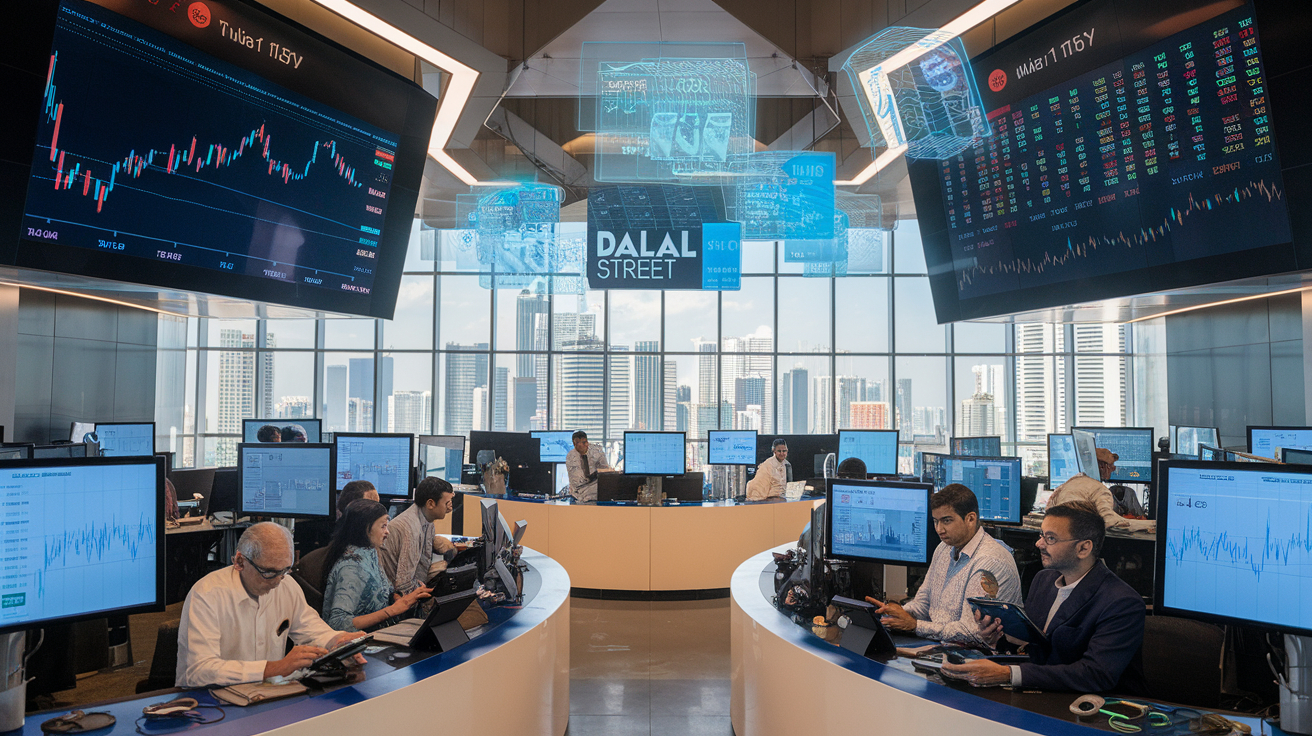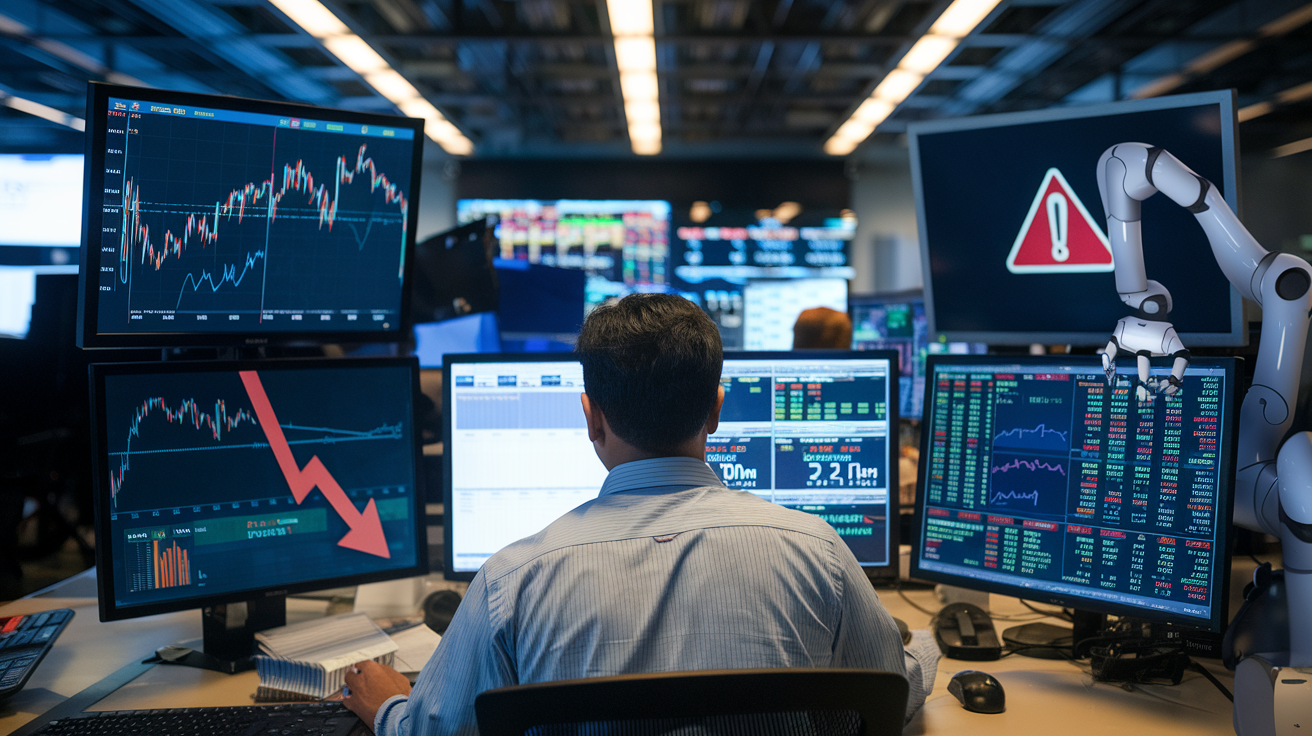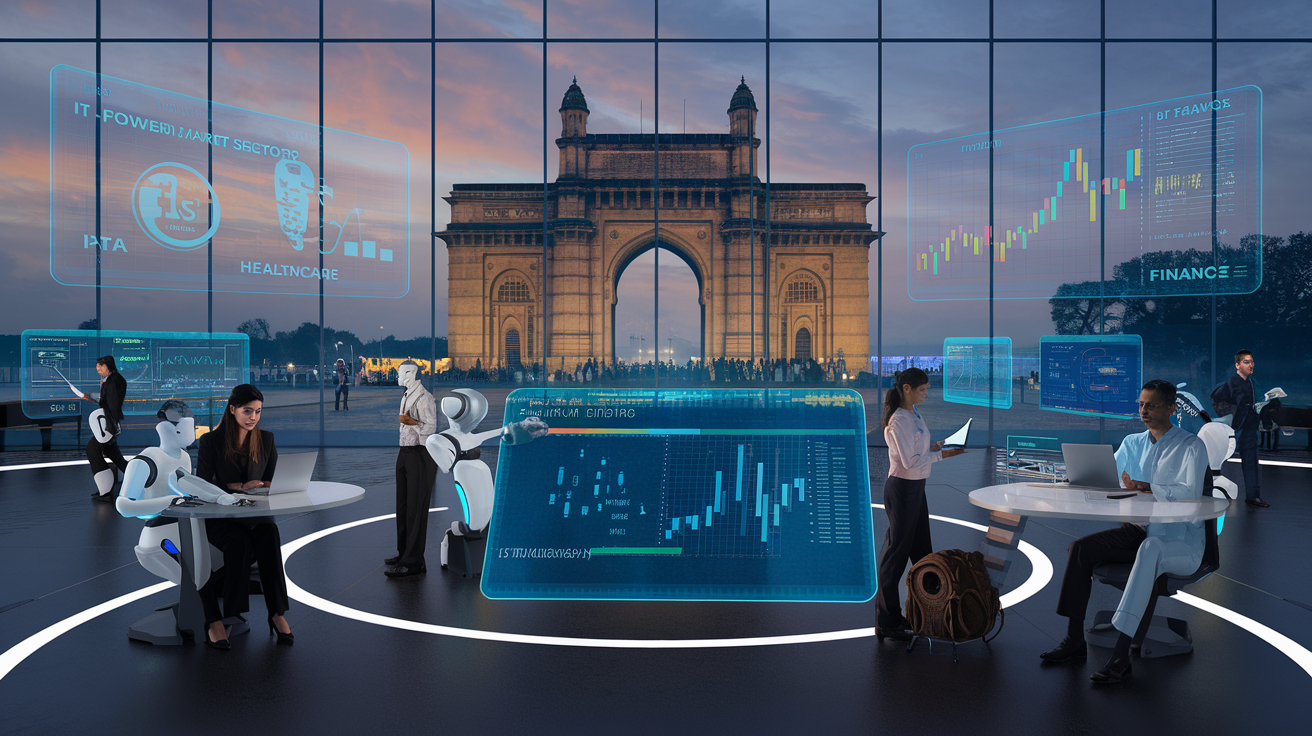How AI Traders Are Reshaping Dalal Street in 2025 in INDIA
How AI Traders Are Reshaping Dalal Street in 2025 in INDIA
Imagine a world where algorithms trade stocks faster than you can blink, where AI analyzes market sentiment in real-time, and where your investment decisions are guided by artificial intelligence. This isn’t science fiction—it’s the reality of Dalal Street in 2025. 🚀💹
As India’s financial markets evolve at breakneck speed, AI traders are reshaping the landscape, bringing unprecedented efficiency and insights to the world of investing. But with great power comes great responsibility—and risk. How will this technological revolution impact different market sectors? What are the limitations and potential pitfalls of relying on AI for trading decisions? And most importantly, how can investors navigate this new terrain to maximize their returns?
In this post, we’ll dive deep into the rise of AI in Indian stock markets, explore the key tools transforming Dalal Street, and examine the regulatory challenges that lie ahead. We’ll also uncover the top AI stocks to watch in 2025 and provide crucial investment considerations for those looking to ride the wave of this technological transformation. Buckle up as we embark on a journey through the cutting-edge world of AI-powered trading in India! 🇮🇳📊
The Rise of AI in Indian Stock Markets

A. Real-time data analysis and trend monitoring
AI has revolutionized stock trading in India by providing powerful tools for real-time data analysis and trend monitoring. These AI-powered systems can process vast amounts of market data instantaneously, identifying patterns and predicting future price movements with unprecedented accuracy. Platforms like StockEdge and Trendlyne offer features that enable traders to:
- Monitor multiple securities across various timeframes
- Identify opportunities created by sector rotations
- Detect liquidity shifts in the market
This capability allows investors to make informed decisions quickly, without the emotional bias that often affects human traders.
B. AI’s role in validating trading strategies
AI algorithms play a crucial role in validating trading strategies, offering several advantages:
- Backtesting: AI can rapidly test strategies against historical data
- Risk assessment: Evaluating potential risks associated with different strategies
- Performance optimization: Fine-tuning strategies for better returns
Kunal Nandwani, CEO of uTrade Solutions, highlights AI’s ability to analyze earnings calls and validate trading strategies, providing traders with valuable insights for decision-making.
C. Market sentiment analysis and personalized recommendations
One of the most significant contributions of AI to stock trading is its capacity for market sentiment analysis and personalized recommendations. AI tools can:
| Capability | Description |
|---|---|
| Sentiment Analysis | Gauge overall market mood by analyzing news, social media, and other data sources |
| Risk Profiling | Tailor recommendations based on individual investor risk profiles |
| Automated Alerts | Provide risk management alerts to help traders minimize losses |
Platforms like TickerTape and Screener.in offer these features, allowing both novice and experienced investors to make more informed decisions.
However, it’s important to note that while AI provides powerful insights, human judgment remains essential. AI may struggle to interpret non-numerical factors such as human psychology and geopolitical events, which can significantly impact markets.
With this understanding of AI’s role in data analysis, strategy validation, and personalized recommendations, we’ll next explore the specific “Key AI Trading Tools Reshaping Dalal Street” that are making waves in India’s stock market landscape.
Key AI Trading Tools Reshaping Dalal Street

Now that we have explored the rise of AI in Indian stock markets, let’s delve into the key AI trading tools reshaping Dalal Street. These innovative technologies are transforming the way traders and investors approach the market, offering advanced capabilities for analysis and decision-making.
A. Trade Ideas for real-time market scanning
Trade Ideas stands out as a cutting-edge platform for active day traders. Its AI-powered real-time market scanning capabilities allow investors to:
- Monitor multiple securities across various timeframes
- Identify opportunities created by sector rotations and liquidity shifts
- Receive AI-generated trading signals
With a high rating of 4.7 for its AI functionalities, Trade Ideas provides traders with a powerful tool for staying ahead in the fast-paced world of stock trading.
B. Tickeron’s user-friendly interface
Tickeron offers a more accessible approach to AI-driven trading, particularly for those new to the world of algorithmic investing. Key features include:
- User-friendly interface for easy navigation
- Portfolio building capabilities
- AI-powered market analysis and recommendations
This platform seamlessly combines advanced AI technology with an intuitive design, making it an excellent choice for both novice and experienced traders.
C. TrendSpider for technical analysis automation
TrendSpider excels in automating technical analysis, earning a high rating of 4.8 for its AI capabilities. The platform offers:
| Feature | Description |
|---|---|
| AI pattern recognition | Automatically identifies chart patterns and trends |
| Backtesting functionality | Allows users to test strategies against historical data |
| Technical analysis tools | Provides advanced charting and analysis features |
These features make TrendSpider particularly valuable for traders who rely heavily on technical analysis in their decision-making process.
D. Other notable tools: MetaTrader, QuantConnect, Alpaca
Several other AI trading tools are making waves in the Indian market:
- MetaTrader: Known for its robust algorithmic trading capabilities
- QuantConnect: Offers a cloud-based platform for developing and testing trading algorithms
- Alpaca: Provides API-first brokerage services for algorithmic trading
These platforms, along with others like Incite AI and SignalStack, offer unique features that cater to different trading styles and preferences.
As we move forward to discuss AI’s impact on trading efficiency, it’s important to note that while these tools offer significant advantages, experts caution against blind trust in AI for trading decisions. The next section will explore how these AI technologies are revolutionizing trading efficiency on Dalal Street, while also considering the limitations and risks associated with over-reliance on automated systems.
AI’s Impact on Trading Efficiency

Now that we’ve explored the key AI trading tools reshaping Dalal Street, let’s delve into how these technologies are impacting trading efficiency on the Indian stock market.
A. Handling labor-intensive tasks
AI has revolutionized the way labor-intensive tasks are managed in stock trading. By automating processes that were once manual and time-consuming, AI significantly enhances efficiency:
- Data Analysis: AI algorithms can process vast datasets rapidly, identifying patterns and trends that human analysts might miss.
- Portfolio Management: Automated systems continuously monitor and adjust portfolios based on real-time market conditions.
- Risk Assessment: AI tools quickly evaluate potential risks across multiple securities and market sectors.
B. Monitoring multiple securities across timeframes
One of the most significant advantages of AI in trading is its ability to simultaneously monitor numerous securities across various timeframes:
| Capability | Impact on Trading |
|---|---|
| Real-time analysis | Instant identification of trading opportunities |
| Multi-timeframe monitoring | Comprehensive market view for better decision-making |
| Automated alerts | Timely notifications for potential entry or exit points |
This capability allows traders to stay informed about market movements across different sectors and time horizons, leading to more informed and timely trading decisions.
C. Identifying opportunities from sector rotations and liquidity shifts
AI’s advanced analytical capabilities extend to recognizing complex market dynamics:
-
Sector Rotation Analysis:
- AI algorithms detect shifts in capital flow between market sectors
- Predictive models forecast potential sector performance based on economic indicators
-
Liquidity Shift Identification:
- Real-time monitoring of trading volumes and order book depth
- Automated detection of unusual trading activity that may indicate significant market moves
By leveraging these AI-driven insights, traders can capitalize on emerging opportunities and adjust their strategies to align with evolving market conditions.
With this enhanced efficiency in trading operations, it’s important to consider the potential limitations and risks associated with AI trading, which we’ll explore in the next section.
Limitations and Risks of AI Trading

Now that we’ve explored AI’s impact on trading efficiency, it’s crucial to consider the limitations and risks associated with AI trading. While AI has undoubtedly transformed Dalal Street, it’s not without its challenges.
A. Challenges in interpreting non-numerical factors
AI trading systems excel at processing vast amounts of numerical data, but they face significant hurdles when it comes to interpreting non-numerical factors. These systems may struggle to accurately assess:
- Geopolitical events
- Regulatory changes
- Company reputation shifts
- Social media sentiment
This limitation can lead to incomplete market analysis and potentially flawed trading decisions.
B. Vulnerabilities during unprecedented market conditions
AI trading algorithms are typically trained on historical data, which can leave them vulnerable during unprecedented market conditions. The Reserve Bank of India’s (RBI) Financial Stability Report highlights several key risks:
| Risk Factor | Potential Impact |
|---|---|
| Increased interconnectedness | Rapid propagation of disruptions across the system |
| Elevated cybersecurity threats | Sophisticated AI-driven phishing and deepfakes |
| Heightened market volatility | Exacerbation of market instability through rapid trading actions |
During stressful periods, AI-driven leveraged trades can amplify market instability through feedback loops, potentially leading to significant financial losses.
C. The need for human judgment alongside AI insights
While AI offers powerful insights, the importance of human judgment in trading decisions cannot be overstated. Human traders bring valuable qualities to the table that AI currently lacks:
- Contextual understanding of complex market dynamics
- Ability to interpret qualitative information
- Intuition based on years of experience
- Ethical decision-making capabilities
Experts, including those from the International Monetary Fund (IMF), recognize the dual nature of AI’s impact on market efficiency and volatility. This underscores the need for a balanced approach that combines AI’s analytical power with human expertise.
As we move forward to discuss the regulatory landscape for AI in Indian capital markets, it’s clear that addressing these limitations and risks will be crucial for maintaining financial stability and security in the evolving AI-driven trading ecosystem.
Regulatory Landscape for AI in Indian Capital Markets

Now that we’ve explored the limitations and risks of AI trading, let’s delve into the regulatory landscape that governs AI in Indian capital markets. The Securities and Exchange Board of India (SEBI) has been proactive in addressing the challenges and opportunities presented by AI technologies.
SEBI’s exploration of AI for IPOs and mutual funds
SEBI has been actively exploring the integration of AI technologies in various aspects of capital markets, including Initial Public Offerings (IPOs) and mutual funds. While specific details on these explorations are not provided in the reference content, it’s clear that SEBI is adapting to the changing technological landscape.
Developing guidelines for AI technologies
In February 2025, SEBI introduced significant amendments to its Intermediaries Regulations, focusing on the use of AI in the financial sector. These new guidelines emphasize:
- Privacy and security of investor data
- Integrity of stakeholder information
- Responsibility for AI-generated outputs
Key points of the new regulations include:
| Aspect | Requirement |
|---|---|
| Responsibility | Full accountability for AI tool usage |
| Compliance | Adherence to existing laws |
| Scope | Applies to SEBI-regulated entities |
| AI Definition | Includes software for investment, trading, and compliance |
Addressing transparency and accountability concerns
To address concerns about transparency and accountability, SEBI has implemented several measures:
- Introduced Regulation 82-AA for depositories using AI
- Mandated 15% monthly interest for delays in annual fee payments
- Extended responsibility to AI tools developed by SEBI or third-party providers
These regulations aim to ensure that entities using AI technologies:
- Safeguard investor and stakeholder data
- Maintain the integrity of financial operations
- Take full responsibility for AI-generated outputs
With this comprehensive regulatory framework in place, we can now explore how AI is influencing different market sectors in India’s evolving financial landscape.
AI’s Influence on Different Market Sectors

Now that we have covered the regulatory landscape for AI in Indian capital markets, let’s explore how AI is influencing different market sectors in India.
A. Finance: IRFC share price movements
AI’s impact on the financial sector is particularly evident in the analysis of share price movements. For instance, the Indian Railway Finance Corporation (IRFC) has seen significant fluctuations in its stock value, influenced by AI-driven trading algorithms. These sophisticated tools analyze vast amounts of data, including:
- Historical price trends
- Market sentiment
- Economic indicators
- Company performance metrics
AI systems can process this information at speeds far surpassing human capabilities, leading to more rapid and potentially more accurate trading decisions. This has resulted in increased volatility and liquidity in IRFC shares, as AI traders quickly respond to market changes.
B. Cryptocurrency: Bitcoin and Ethereum trends
The cryptocurrency market, particularly Bitcoin and Ethereum, has been significantly impacted by AI technologies. AI algorithms are being used to:
- Predict price movements
- Identify trading opportunities
- Manage risk in crypto portfolios
| AI Application | Impact on Crypto Trading |
|---|---|
| Price Prediction | More accurate forecasting of short-term price fluctuations |
| Pattern Recognition | Identification of complex market trends and cycles |
| Sentiment Analysis | Gauging market sentiment from social media and news sources |
These AI-driven insights have contributed to the increased adoption of cryptocurrencies in India, despite regulatory uncertainties.
C. Technology: Advancements in AI coding and chatbots
The technology sector in India has seen remarkable growth, particularly in AI coding and chatbot development. This progress is reshaping various industries:
- Customer Service: AI-powered chatbots are enhancing customer interactions across sectors like retail, banking, and healthcare.
- Software Development: AI coding assistants are boosting productivity in IT companies, accelerating software development cycles.
- Process Automation: AI is streamlining operations in manufacturing and logistics, improving efficiency and reducing costs.
These advancements are not only transforming existing businesses but also fostering a new wave of AI-focused startups in India’s tech ecosystem.
As we look ahead to the next section on AI-driven personalized learning in education, it’s clear that the influence of AI extends far beyond the financial and technology sectors, promising to revolutionize how we approach learning and skill development in India.
AI-Driven Personalized Learning in Education

Now that we’ve explored AI’s influence on different market sectors, let’s delve into how AI is reshaping education in India through personalized learning.
A. Tailored educational pathways based on individual needs
AI-driven platforms like Byju’s are revolutionizing the Indian education system by offering personalized learning paths. These intelligent tutoring systems analyze individual student data to:
- Identify knowledge gaps
- Adapt content difficulty
- Suggest tailored study materials
This personalization addresses the diverse learning needs of India’s large student population, providing quality education even in remote areas.
| AI Feature | Benefit |
|---|---|
| Data analysis | Identifies individual strengths and weaknesses |
| Adaptive content | Adjusts difficulty based on student performance |
| Resource suggestion | Recommends targeted study materials |
B. Enhancing creativity, confidence, and curiosity
AI-powered education tools are fostering a more engaging learning environment:
- Immersive virtual environments
- Language learning tools
- AI-driven exam preparation resources
These technologies not only make learning more interactive but also boost students’ creativity and curiosity. By providing immediate feedback and support, AI helps build confidence in learners, encouraging them to explore new concepts and ideas.
C. Benefits for educators and parents
AI in education offers significant advantages for teachers and parents:
- Administrative automation: Reduces teachers’ workload, allowing more focus on student interaction
- Enhanced accessibility: Provides better support for students with disabilities
- Progress tracking: Offers detailed insights into student performance for both educators and parents
The National Education Policy (NEP) 2020 and initiatives like PM eVIDYA are actively promoting AI integration in classrooms, aiming to create a more inclusive and impactful learning ecosystem.
As we transition to the economic impact of AI in India, it’s clear that the transformation in education will play a crucial role in shaping the country’s future workforce and economic landscape.
Economic Impact of AI in India

Now that we’ve explored AI-driven personalized learning in education, let’s examine the broader economic impact of AI in India.
Projected market growth and contribution to the economy
The integration of AI across various sectors in India is poised to significantly boost the economy. While specific growth figures for AI in India aren’t provided in the reference content, we can infer its potential based on global trends:
- AI is reshaping major industries like finance and technology
- Companies like Zoho, SatLeo Labs, and Cognizant are making headlines with AI advancements
- Microsoft reports that AI now contributes 30% of code in their development processes
This widespread adoption suggests a substantial contribution to India’s economic growth, potentially driving innovation and efficiency across multiple sectors.
Adoption across various sectors: education, agriculture, healthcare
AI’s impact is evident across diverse industries in India:
| Sector | AI Applications |
|---|---|
| Education | Personalized learning, chatbots (e.g., Perplexity AI on WhatsApp) |
| Finance | Stock market trading, cryptocurrency analysis |
| Technology | Coding assistance, standalone AI apps (e.g., Meta’s new AI app) |
| Entertainment | Content creation, voice acting (e.g., “Solo Leveling” anime) |
While the reference content doesn’t specifically mention agriculture and healthcare, the broad adoption of AI across other sectors suggests these areas are likely benefiting from AI integration as well.
Key developments highlighting AI’s economic impact:
- Financial sector: AI traders are reshaping Dalal Street, indicating a transformation in stock market operations.
- Cryptocurrency: AI tools are being used to analyze market trends, with Bitcoin reaching $96,957 and Ethereum seeing modest gains.
- Tech innovation: Companies are leveraging AI for product development, such as the introduction of the Moto Razr 60 Ultra.
- Cybersecurity: AI is playing a role in recovering funds from DeFi hacks, as evidenced by Loopscale’s recovery of $2.8M.
With this increasing integration of AI across various sectors, we can anticipate a significant boost to India’s economy. Next, we’ll explore the top AI stocks in India for 2025, which will provide insight into the companies leading this technological revolution.
Top AI Stocks in India for 2025

Now that we’ve examined the economic impact of AI in India, let’s explore some of the top AI stocks in the country for 2025. These companies are at the forefront of AI innovation and are reshaping various sectors of the Indian economy.
A. Affle India: Digital transformation and mobile advertising
Affle India stands out as a leader in digital transformation and mobile advertising. With the AI market in India projected to reach approximately $17 billion by 2027, Affle is well-positioned to capitalize on this growth. The company’s focus on enhancing user engagement through AI-driven solutions aligns with the increasing adoption of AI by Indian companies to improve overall productivity.
B. Zensar Technologies: Digital and engineering services
Zensar Technologies is making significant strides in the AI landscape with its range of digital and engineering services. The company’s commitment to sustainability sets it apart in the competitive tech industry. With a market capitalization that reflects its strong position, Zensar has shown impressive returns:
| Metric | Value |
|---|---|
| 1-year return | 16.69% |
This performance underscores the potential of AI stocks in India’s growing tech sector.
C. Persistent Systems: Intelligent automation and cloud solutions
Persistent Systems is a key player in intelligent automation and cloud solutions across various industries. As AI continues to reshape sectors such as education, agriculture, and healthcare, Persistent’s offerings are becoming increasingly relevant. The company’s focus on these critical areas aligns with the projected contribution of AI to India’s economy, which could reach $957 billion by 2035.
Other notable companies in the AI space include:
- Bosch: Specializing in industrial technology
- Oracle Financial Services Software: Focusing on financial services
| Company | Market Cap | 1-year Return |
|---|---|---|
| Oracle Financial Services | Rs 61,914.29 crore | 21.05% |
These top AI stocks represent the diversity and potential of India’s AI industry. As we move forward, it’s crucial to consider the investment considerations for AI stocks, which we’ll explore in the next section. Factors such as financial health, competitive dynamics, and ethical practices play a significant role in evaluating these promising opportunities in the rapidly evolving AI landscape.
Investment Considerations for AI Stocks

Now that we’ve explored the top AI stocks in India for 2025, let’s delve into the crucial investment considerations for these AI stocks. Understanding these factors is essential for making informed decisions in this dynamic sector.
A. Evaluating financial health and competitive dynamics
When considering AI stocks, it’s vital to conduct a thorough analysis of the company’s financial health and competitive position. Here are key factors to evaluate:
- Price-to-earnings ratio
- Market capitalization
- Return on investment
- Profit margins
For example, let’s compare two leading AI stocks:
| Company | Market Cap (Rs Crore) | 1-Year Return | P/E Ratio |
|---|---|---|---|
| Oracle Financial Services | 61,914.29 | 21.05% | N/A |
| Zensar Technologies | N/A | 16.69% | N/A |
Investors should also assess the management team’s capabilities and the company’s competitive advantages in the AI sector.
B. Ensuring ethical practices and regulatory compliance
As the AI industry evolves, regulatory challenges and ethical considerations become increasingly important. When investing in AI stocks, consider:
- The company’s adherence to data privacy regulations
- Ethical use of AI technologies
- Compliance with evolving AI-specific regulations
Stay informed about the regulatory landscape for AI in Indian capital markets to make well-informed investment decisions.
C. Importance of diversification and thorough research
To mitigate risks associated with AI stocks, consider the following:
- Diversify your portfolio across different AI-related sectors
- Conduct in-depth research on individual companies
- Monitor market conditions and technological advancements
Tools like Tickertape can assist in portfolio analysis and enhance your investment strategy in the AI sector.
Remember, while AI stocks offer significant growth potential, they also come with inherent risks such as market volatility and technological disruptions. Maintain a long-term investment perspective and regularly reassess your investment choices based on changing market dynamics and individual company performance.

As AI continues to reshape Dalal Street in 2025, investors and market participants must adapt to this new era of algorithmic trading. The rise of AI in Indian stock markets has brought increased efficiency, personalized investment strategies, and enhanced market analysis. However, it’s crucial to recognize the limitations and risks associated with AI trading, particularly in interpreting non-numerical factors and unprecedented market conditions.
The regulatory landscape in India is evolving to accommodate these technological advancements, with SEBI exploring AI’s potential while addressing transparency and accountability concerns. As we look ahead, the integration of AI across various sectors, from finance to education, promises significant economic impact and growth opportunities. Investors interested in AI stocks should carefully evaluate financial health, competitive dynamics, and ethical practices while maintaining a diversified portfolio. Ultimately, the future of trading on Dalal Street lies in striking a balance between leveraging AI’s capabilities and applying human judgment to navigate the complexities of the market.
